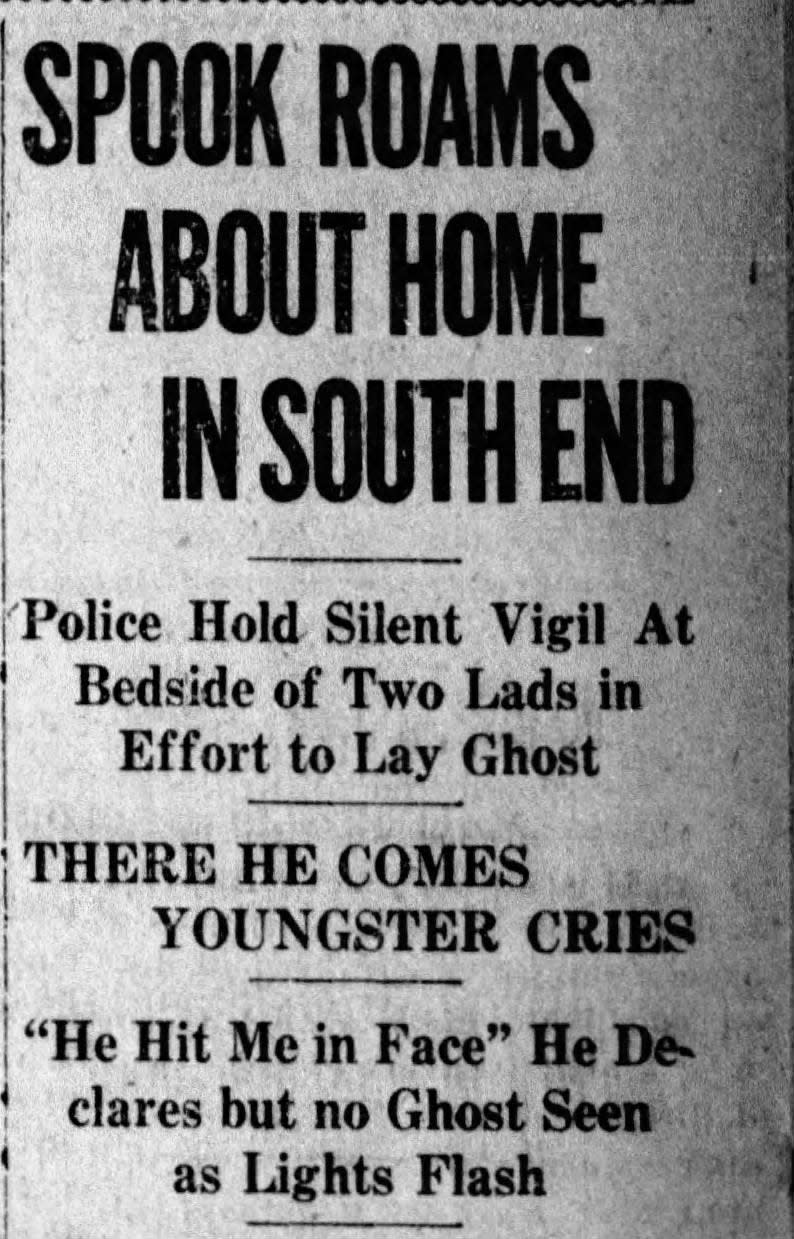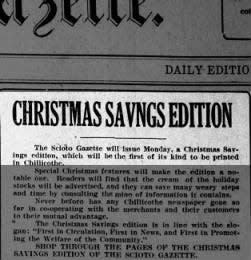Looking Back: A review of 1923
Note to readers. This column is not a comprehensive review of 1923. Instead, it is one story from each month of that year. These 12 stories, when taken as a whole, hopefully provide a snapshot view of life in Chillicothe 100 years ago.
January: The new year was barely a week old when perhaps the strangest story of the year appeared on the front page of the Gazette. Chillicothe police were called to the home of W.W. Wilson on 283 S. Paint St. to investigate the alleged assault on two young boys by a ghost, one who pointed to his bloody nose as evidence of the attack. After Chief of Police Fox arrived, he ordered the two boys to bed, pulled up a chair and waited for the ghost to make a reappearance. After five minutes of silence, a series of sharp raps sounded, but when the lights were turned on the source of the noise could not be found. Minutes later a faint scratching was heard from the floor and Fox discovered one of the boys with his arm hanging off the side of the bed and accused him of being the “ghost.” However, the boy’s protestations of his innocence were so sincere that the lights were turned off again and the vigil continued. A short time later, one of the boys cried “There he comes! There he comes! There he comes.” A distinct slap, as in flesh meeting flesh was heard and the boy screamed, “He hit me in the face.” Police discounted the theory that it was a supernatural occurrence and attributed it to human causes.

February: Prohibition of alcohol was still in full swing in 1923 and stories of moonshiners and bootleggers appeared almost daily on the pages of the Gazette. On the last day of February, state dry agents descended on the city and raided several locations, including a café on W. Water St. owned by Harry Hutchinson. Agents had searched the place five times in the previous four days and come up empty, but this time they turned the place upside down and found Hutchinson’s hiding place. The authorities confiscated six-gallon jugs of white corn whisky and the frosted white glasses he allegedly used to serve his customers. Interestingly, one of the agents was Hutchinson’s uncle and he was forced to arrest his nephew.
March: On the first day of March, John Wargo of East Main St. was backing up a big truck and accidentally bumped into a cylinder of chlorine gas stacked on a platform at a warehouse at Camp Sherman. The shell came crashing down, breaking off the valve and sending a yellow cloud of the deadly gas into the air. The cone-shaped cloud clung close to the ground and slowly spread in the direction of Chillicothe, killing all the vegetation in its path. The wounded war veterans at the camp, according to the Gazette, “sniffed at the familiar smell, but few really knew they were going through another gas attack.” Luckily, the deadly cloud scattered over a wide area and did no damage.
April: The increasing importance of the automobile in American life sparked a lively debate in Chillicothe about the need for a camp to accommodate auto tourists who preferred to spend the night in their cars rather than hotels or private residences. “With Mount Logan one of the show spots in Ohio history,” the Gazette argued, “coupled with the proposed opening of the Mound City Park, it is believed that many auto tourists will make Chillicothe one of their stops on their season’s itinerary.” It was suggested that a camp be built in Yoctangee Park where tourists could build campfires, access clean water and even electric lights. In the end, it was decided there were not enough motor tourists for it to pay off and officials worried that “the camp would become a nuisance and a place for loafing.”
May: On the evening of May 14, Ross County Sheriff Donald Swepston received an unusual call. A band of about 30 Gypsies were reportedly entering homes, taking what they wanted and scaring children. The nomadic band was led by a woman allegedly 115-years-old, and Swepston escorted the group through the city and “shooed” them south toward Portsmouth. They returned to Ross County in August claiming they wanted to tell fortunes but instead started picking pockets. The band slipped into Chillicothe but a flanking movement by police rounded them up and pushed them out of the city.

June: “Merciful wind, sing us a hoarse, rough song, for there is music made here today that we fain would not hear.” In June, this snippet from a poem was on the minds of farmers after the 17-year locusts (cicadas) flocked into Ross County. They first made their appearance in Bainbridge, and according to the Gazette, “settled over, under and on everything in sight.” Farmers walking through their fields felt the crunch of the insects under their feet as the pests swarmed “about their head and shoulders.” The noise created by the insects reportedly sounded like the “far off hum of battle planes.”
July: On Tues. afternoon, July 24, Ross County Sheriff Donald Swepston led a posse of farmers armed with guns, clubs and pitchforks on a manhunt to locate a man described as “strange” and “running amuck” in Union Township. It seems that when the boys and men were in the fields or the families at church, the man used a skeleton key to enter homes, lighting lamps, rummaging through drawers, but without ever taking a single item. Before leaving, he would turn the lamps down low and carefully lock the doors. However, on one occasion he confronted a woman who was milking a cow: “That’s the last time you’ll ever milk a cow,” he threatened. Although he was not brandishing a weapon, it was enough to launch the angry posse of farmers. There was no follow-up story, so it is likely the stranger successfully hightailed it out of town.
August: “FIRST OHIO FLAPPER LIVED IN ROSS ABOUT 7,000 YEARS AGO” splashed across the Gazette’s front page on Aug. 15. Archeologists at the Hopewell Mound Group unearthed the remains of a woman and 24 earrings, some with pearls inlaid in the design and made from copper, stone, mica and bone. The copper earrings were shaped like hourglasses and the bone and stone ones like barrels. The Gazette could not help but tease the controversial flappers of the day who were fond of wearing lots of jewelry, including dangling earrings. “If some Chillicothe maiden could secure a pair of these ornaments,” the paper teased, “she would certainly have something which would put the modern ones in the shade.”
September: In the Autumn of 1923, five years after it had been defeated in World War I, Germany was in crisis and teetering on civil war. Although the monarchy had been replaced by a democratic Republic and the newly drafted constitution, on paper at least, promised a near-perfect democracy, it didn’t matter because the people did not want it. On Sept. 25, the Gazette printed the first and only known photograph in existence of Adolf Hitler, who was still largely unknown, even to Germans. Readers came to know Hitler’s name better when less than two months later he and his Nazi thugs unsuccessfully tried to overthrow the government and the future dictator was arrested and put in jail.
October: The Mead paper plant had gone two years without a fatal accident but that came to an end Saturday morning, Oct. 20. Lewis E. Huber was pounding out the wrinkles on a roll of paper when the wooden club he was using slipped from his hands. The club started through the machine and Huber reached for it, but his hands got caught between the rolls and he was pulled through the machine to the waist, crushing his head and body. Huber had worked at the plant since 1914 and served in WWI.
November: Increasing automobile ownership resulted in many predictable problems, including accidents, drunk driving, speeding, traffic chaos and illegal parking. However, as the year drew to a close, a front-page story highlighted another issue. Automobile owners were required to purchase new license plates at the end of each year, but almost everyone procrastinated and bombarded the registrar at the last minute. In a November article, the Gazette warned its readers that 250 licenses would have to be sold each day until the end of the year and “that if owners put off getting licenses it will be a physical impossibility to distribute all in time.” The year before was a disaster and owners were warned that “no extension of time will be granted this year.”
December: On Dec. 10, the Gazette delivered its first annual Christmas Savings edition to its 8,500 subscribers. With a total of 40 pages, it was one of the largest editions in the paper’s history. “The advertisements in this edition,” claimed the Gazette, “were not ordinary advertisements but messages concerning the cream of the holiday trade.” Shoppers descended downtown, the special edition in hand, saving many steps locating which stores carried the children’s toys they were looking for, or that latest modern phonograph for dad or jewelry for mom. Long before the internet, this cooperation between merchants and customers was innovative and a big hit.

This article originally appeared on Lancaster Eagle-Gazette: Looking Back: What did the Gazette report on in 1923?

